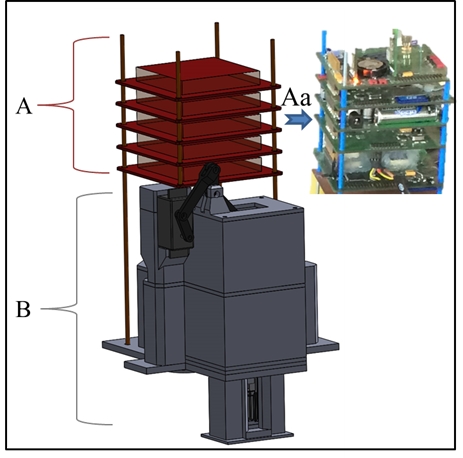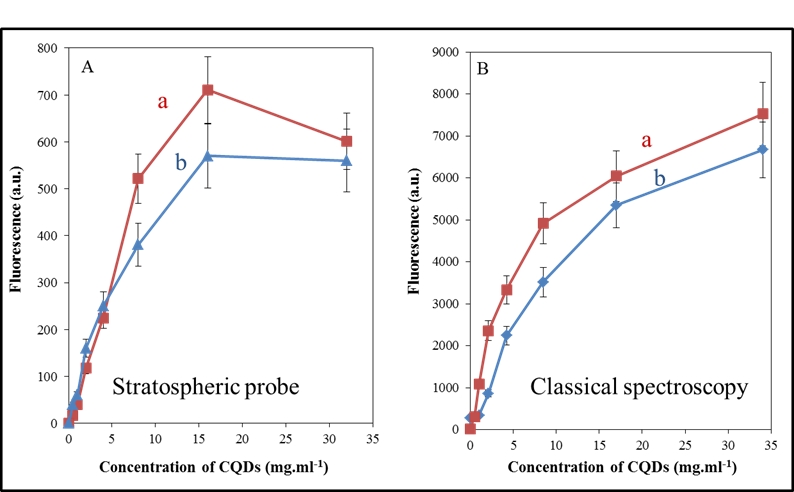
Fluorescence detection of carbon quantum dots assessed by stratospheric platform
Lukas Nejdl, Jan Zitka, Kristyna Cihalova, Vedran Milosavljevic, Amitava Moulick, Ondrej Zavodsky, Zbynek Heger, Jakub Kapus, Libor Lenza, Vojtech Adam and Rene Kizek
Measurement of molecular fluorescence is one of the most sensitive methods to detect the signal of interest. It can be realized in numerous arrangements including flow-through geometry (i. e. chromatography, capillary electrophoresis) [1,2], imaging and microscopy [3,4], however the most commonly used is the stationary fluorescence spectrometry [5]. The diversity of the detectors is based on several factors such as light source and/or geometry of the detection cell. Currently, the utilization of the light emitting diodes as a light source is a trend enabling miniaturization of the instrumentation [6-8]. The portable devices moreover allow the in situ analyses, which have number of advantages such as obtaining the data in real time, lowering the time of the analysis as well as its costs. Especially in cases where the detection site is difficult to reach, the remote-controlled analyzers are beneficial. Stratosphere is one of these hard-to reach places and therefore stratospheric or space research is a new challenge for these devices [9]. Nowadays, balloons are a main tool for stratospheric in situ research mostly focused on the stratosphere composition. In case that balloon is above the ozone layer, nearly the same radiation as in free space affects the balloon. This fact is used to test durability of space materials in cheap way [10]. Ghysels et al. used optical sensor carried by balloon to quantify amount of carbonic dioxide in upper parts of troposphere and stratosphere [11]. Photometric quantification was also used to quantify vertical distribution of oxides of bromine [12]. However, to our knowledge, no fluorimetric device has been used in stratospheric conditions so far. To monitor the behavior of the detector above the ground, carbon quantum dots (CQDs) can be employed. CQDs are new type of nanomaterial. They retain portion of bulk material properties and gain new, which arise from their nanometer diameter. They are biocompatible and possess chemical inertness and low toxicity [13]. The importance of CQDs is reflected in their electronic, mechanical, chemical and optical properties. All of these properties allow using CQDs in different fields of research such as catalysis, sensing, bioimaging, tissue engineering, optoelectronic and electronic devices [14-16]. The fluorescent labeling of DNA using nanoparticles enables DNA to be observable in in vivo or in vitro experiments [17]. The aim of this work was to test the fluorescence analyzer made by 3D printer in stratospheric conditions. For testing of this stratospheric equipment 0-32 mg.ml-1 CQDs were used. Testing was performed prior and after the return of stratospheric probe from the stratosphere
![Figure 1: Lecture by Associate Professor Vojtech
Adam of Mendel University in Brno on the role of
metallothionein in cancer [1]. houbova](pics/nejdl1.jpg)
Figure 1: (A) 3D printer with detection part of probe. (B) 3D model of stratospheric probe detection part.

Figure 2: (A) 3D model of flight computer Julo-X and its real photo (Aa). B) Schematic illustration of miniaturized fluorescence analyzer connected with Julo-X.
![Figure 1: Lecture by Associate Professor Vojtech
Adam of Mendel University in Brno on the role of
metallothionein in cancer [1]. houbova](pics/nejdl3.jpg)
Figure 3: (A) Test of communication between the stratospheric probe and the control center. (B) Filling of latex balloon with helium. (C) Localization of the stratospheric probe by radio signal.

Figure 4: (A) Fluorescent activity of 0-32 mg.ml-1 CQDs determined by stratospheric probe a) before launch, b) after landing probe. (B) Fluorescent activity of 0-32 mg.ml-1 CQDs determined by fluorescence analyzer a) before launch in the laboratory, b) after landing probe in the laboratory.
1. de Kort, B.J.; de Jong, G.J.; Somsen, G.W. Native fluorescence detection of biomolecular and pharmaceutical compounds in capillary electrophoresis: Detector designs, performance and applications: A review. Analytica Chimica Acta 2013, 766, 13-33.
2. Smalley, M.B.; McGown, L.B. Fluorescence detectors in hplc. In Advances in chromatography, vol 37, Brown, P.R.; Grushka, E., Eds. 1997; Vol. 37, pp 29-71.
3. Michalet, X.; Siegmund, O.H.W.; Vallerga, J.V.; Jelinsky, P.; Millaud, J.E.; Weiss, S. Detectors for single-molecule fluorescence imaging and spectroscopy. Journal of Modern Optics 2007, 54, 239-281.
4. Spring, K.R. Detectors for fluorescence microscopy. Scanning Microscopy 1991, 5, 63-69.
5. Agbaria, R.A.; Oldham, P.B.; McCarroll, M.; McGown, L.B.; Warner, I.M. Molecular fluorescence, phosphorescence, and chemiluminescence spectrometry. Analytical Chemistry 2002, 74, 3952-3962.
6. Dasgupta, P.K.; Eom, I.Y.; Morris, K.J.; Li, J.Z. Light emitting diode-based detectors absorbance, fluorescence and spectroelectrochemical measurements in a planar flow-through cell. Analytica Chimica Acta 2003, 500, 337-364.
7. Hillebrand, S.; Schoffen, J.R.; Mandaji, M.; Termignoni, C.; Grieneisen, H.P.H.; Kist, T.B.L. Performance of an ultraviolet light-emitting diode-induced fluorescence detector in capillary electrophoresis. Electrophoresis 2002, 23, 2445-2448.
8. Yang, B.C.; Guan, Y.F. Light-emitting-diode-induced fluorescence detector for capillary electrophoresis using optical fiber with spherical end. Talanta 2003, 59, 509-514.
9. In European rocket & balloon programmes and related research, Thun, Switzerland, 2013; Thun, Switzerland.
10. Kondyurin, A.; Kondyurina, I.; Bilek, M. Radiation damage of polyethylene exposed in the stratosphere at an altitude of 40 km. Polym. Degrad. Stabil. 2013, 98, 1526-1536.
11. Ghysels, M.; Durry, G.; Amarouche, N. Pressure-broadening and narrowing coefficients and temperature dependence measurements of co2 at 2.68 mu m by laser diode absorption spectroscopy for atmospheric applications. Spectroc. Acta Pt. A-Molec. Biomolec. Spectr. 2013, 107, 55-61.
12. Pundt, I.; Pommereau, J.P.; Chipperfield, M.P.; Van Roozendael, M.; Goutail, F. Climatology of the stratospheric bro vertical distribution by balloon-borne uv-visible spectrometry. J. Geophys. Res.-Atmos. 2002, 107.
13. Qian, Z.; Ma, J.; Shan, X.; Shao, L.; Zhou, J.; Chen, J.; Feng, H. Surface functionalization of graphene quantum dots with small organic molecules from photoluminescence modulation to bioimaging applications: An experimental and theoretical investigation. Rsc Advances 2013, 3, 14571-14579.
14. Bai, W.; Zheng, H.; Long, Y.; Mao, X.; Gao, M.; Zhang, L. A carbon dots-based fluorescence turn-on method for DNA determination. Analytical Sciences 2011, 27, 243-246.
15. Xu, X.; Wang, L.; Xu, H.-Q.; Huang, X.-E.; Qian, Y.-D.; Xiang, J. Clinical comparison between paclitaxel liposome (lipusu (r)) and paclitaxel for treatment of patients with metastatic gastric cancer. Asian Pacific Journal of Cancer Prevention 2013, 14, 2591-2594.
16. Yang, T.; Lu, M.M.; Mao, X.L.; Liu, W.H.; Wan, L.; Miao, S.D.; Xu, J.Z. Synthesis of cds quantum dots (qds) via a hot-bubbling route and co-sensitized solar cells assembly. Chem. Eng. J. 2013, 225, 776-783.
17. Sun, D.; Gang, O. DNA-functionalized quantum dots: Fabrication, structural, and physicochemical properties. Langmuir 2013, 29, 7038-7046.
18. Wang, F.; Pang, S.P.; Wang, L.; Li, Q.; Kreiter, M.; Liu, C.Y. One-step synthesis of highly luminescent carbon dots in noncoordinating solvents. Chem. Mat. 2010, 22, 4528-4530.
19. Wang, F.; Pang, S.; Wang, L.; Li, Q.; Kreiter, M.; Liu, C.-y. One-step synthesis of highly luminescent carbon dots in noncoordinating solvents. Chem. Mat. 2010, 22, 4528-4530.
20. Milosavljevic, V.; Nguyen, H.V.; Michalek, P.; Moulick, A.; Kopel, P.; Kizek, R.; Adam, V. Synthesis of carbon quantum dots for DNA labeling and its electrochemical, fluorescent and electrophoretic characterization. Chemical Papers 2014.
J.Met.Nano:
volume-2, issue-3
- Laboratory of Metallomics and Nanotechnologies – an initiator of the Metallomics Scientific Network formation
- Capillary electrophoresis of metallothionein
- Synthetic birnessites and buserites as heavy metal cation traps and environmental remedies
- Immunohistochemical detection of metallothionein
- MALDI-TOF MSI and electrochemical detection of metallothionein in chicken liver after cadmium exposure
- The use of MALDI MSI for the study of different tissues
- Utilization of graphene oxide electrophoretic deposition for construction of electrochemical sensors and biosensors
- Influence of Different Inducers on Ligninolytic Enzyme Activities
- Interaction of nanocarrier apoferritin with cytotoxic drug molecules
- Study of cell penetrating peptide and Europium(III) and Terbium(III) Schiff base complexes interaction
- HPV Detection in Leukocyte Samples of Spinocellular Carcinomas Using PCR
- Characterization of carbon quantum dots by capillary electrophoresis with laser-induced fluorescence detections
- Modification of anti-DNA antibodies with carbon quantum dots
- Fluorescence detection of carbon quantum dots assessed by stratospheric platform
 PDF
PDF